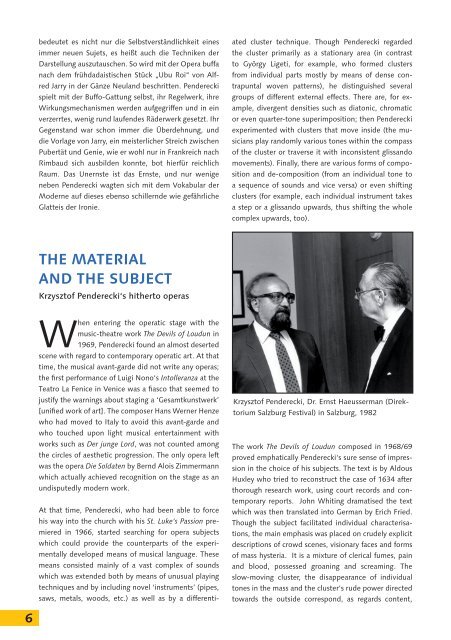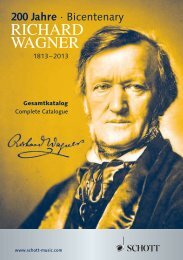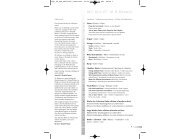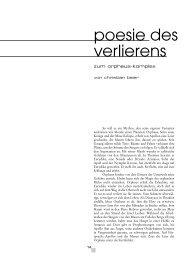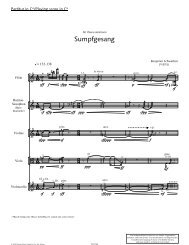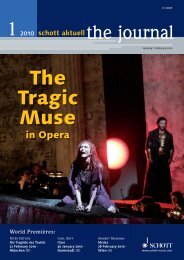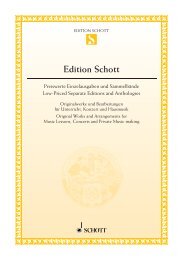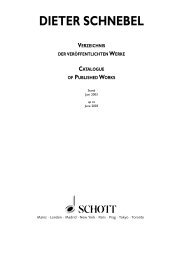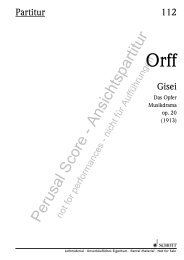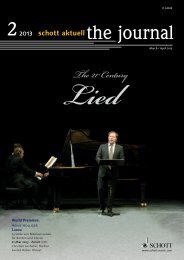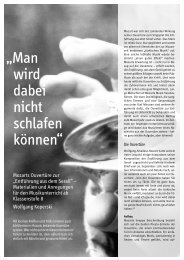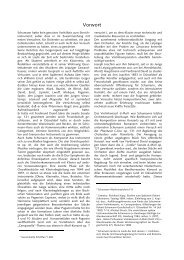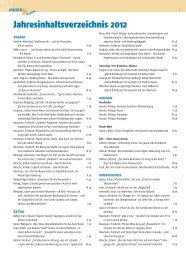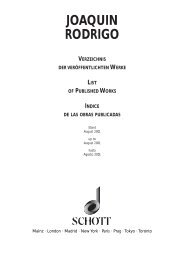Krzysztof PenderecKi - Schott Music
Krzysztof PenderecKi - Schott Music
Krzysztof PenderecKi - Schott Music
Sie wollen auch ein ePaper? Erhöhen Sie die Reichweite Ihrer Titel.
YUMPU macht aus Druck-PDFs automatisch weboptimierte ePaper, die Google liebt.
6<br />
bedeutet es nicht nur die Selbstverständlichkeit eines<br />
immer neuen Sujets, es heißt auch die Techniken der<br />
Darstellung auszutauschen. So wird mit der Opera buffa<br />
nach dem frühdadaistischen Stück „Ubu Roi“ von Alfred<br />
Jarry in der Gänze Neuland beschritten. Penderecki<br />
spielt mit der Buffo-Gattung selbst, ihr Regelwerk, ihre<br />
Wirkungsmechanismen werden aufgegriffen und in ein<br />
verzerrtes, wenig rund laufendes Räderwerk gesetzt. Ihr<br />
Gegenstand war schon immer die Überdehnung, und<br />
die Vorlage von Jarry, ein meisterlicher Streich zwischen<br />
Pubertät und Genie, wie er wohl nur in Frankreich nach<br />
Rimbaud sich ausbilden konnte, bot hierfür reichlich<br />
Raum. Das Unernste ist das Ernste, und nur wenige<br />
neben Penderecki wagten sich mit dem Vokabular der<br />
Moderne auf dieses ebenso schillernde wie gefährliche<br />
Glatteis der Ironie.<br />
tHe MAteriAL<br />
And tHe subject<br />
<strong>Krzysztof</strong> Penderecki‘s hitherto operas<br />
When entering the operatic stage with the<br />
music-theatre work The Devils of Loudun in<br />
1969, Penderecki found an almost deserted<br />
scene with regard to contemporary operatic art. At that<br />
time, the musical avant-garde did not write any operas;<br />
the first performance of Luigi Nono‘s Intolleranza at the<br />
Teatro La Fenice in Venice was a fiasco that seemed to<br />
justify the warnings about staging a ‘Gesamtkunstwerk’<br />
[unified work of art]. The composer Hans Werner Henze<br />
who had moved to Italy to avoid this avant-garde and<br />
who touched upon light musical entertainment with<br />
works such as Der junge Lord, was not counted among<br />
the circles of aesthetic progression. The only opera left<br />
was the opera Die Soldaten by Bernd Alois Zimmermann<br />
which actually achieved recognition on the stage as an<br />
undisputedly modern work.<br />
At that time, Penderecki, who had been able to force<br />
his way into the church with his St. Luke‘s Passion premiered<br />
in 1966, started searching for opera subjects<br />
which could provide the counterparts of the experimentally<br />
developed means of musical language. These<br />
means consisted mainly of a vast complex of sounds<br />
which was extended both by means of unusual playing<br />
techniques and by including novel ‘instruments’ (pipes,<br />
saws, metals, woods, etc.) as well as by a differenti-<br />
ated cluster technique. Though Penderecki regarded<br />
the cluster primarily as a stationary area (in contrast<br />
to György Ligeti, for example, who formed clusters<br />
from individual parts mostly by means of dense contrapuntal<br />
woven patterns), he distinguished several<br />
groups of different external effects. There are, for example,<br />
divergent densities such as diatonic, chromatic<br />
or even quarter-tone superimposition; then Penderecki<br />
experimented with clusters that move inside (the musicians<br />
play randomly various tones within the compass<br />
of the cluster or traverse it with inconsistent glissando<br />
movements). Finally, there are various forms of composition<br />
and de-composition (from an individual tone to<br />
a sequence of sounds and vice versa) or even shifting<br />
clusters (for example, each individual instrument takes<br />
a step or a glissando upwards, thus shifting the whole<br />
complex upwards, too).<br />
<strong>Krzysztof</strong> Penderecki, Dr. Ernst Haeusserman (Direktorium<br />
Salzburg Festival) in Salzburg, 1982<br />
The work The Devils of Loudun composed in 1968/69<br />
proved emphatically Penderecki‘s sure sense of impression<br />
in the choice of his subjects. The text is by Aldous<br />
Huxley who tried to reconstruct the case of 1634 after<br />
thorough research work, using court records and contemporary<br />
reports. John Whiting dramatised the text<br />
which was then translated into German by Erich Fried.<br />
Though the subject facilitated individual characterisations,<br />
the main emphasis was placed on crudely explicit<br />
descriptions of crowd scenes, visionary faces and forms<br />
of mass hysteria. It is a mixture of clerical fumes, pain<br />
and blood, possessed groaning and screaming. The<br />
slow-moving cluster, the disappearance of individual<br />
tones in the mass and the cluster‘s rude power directed<br />
towards the outside correspond, as regards content,


